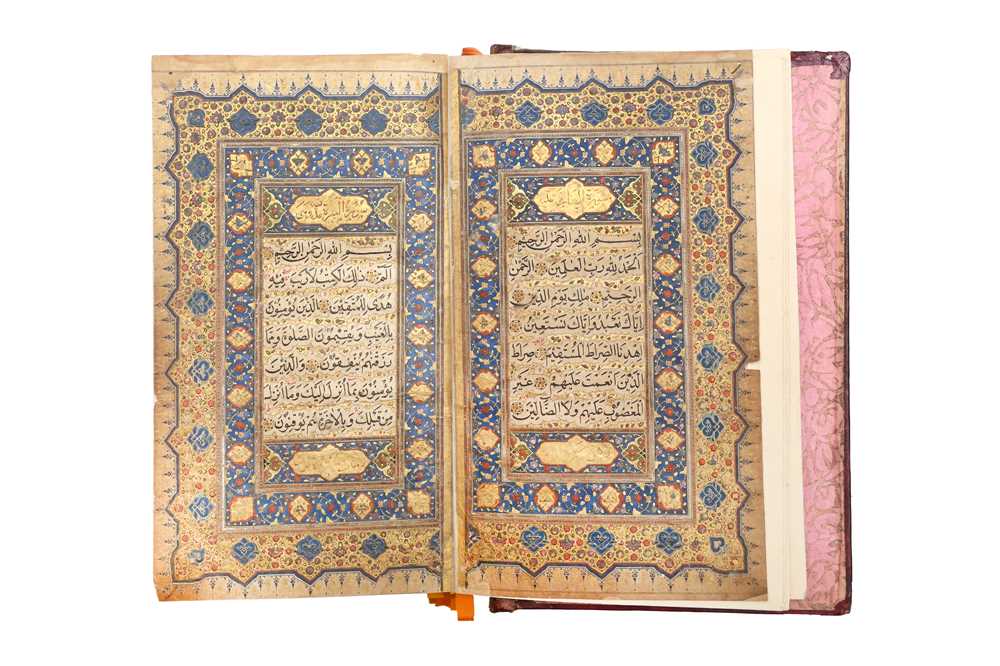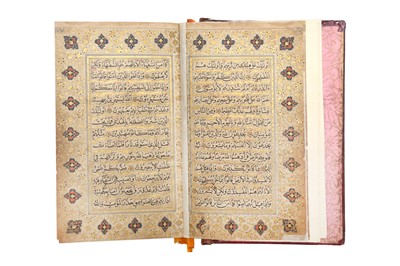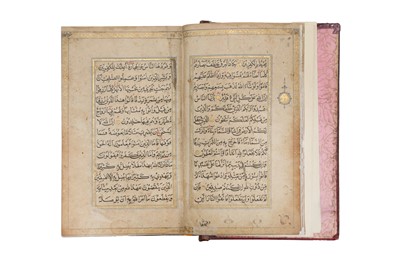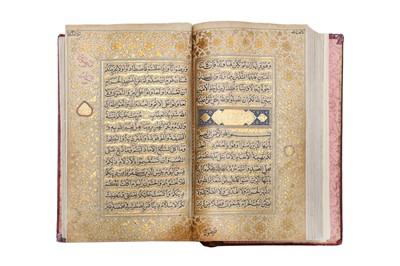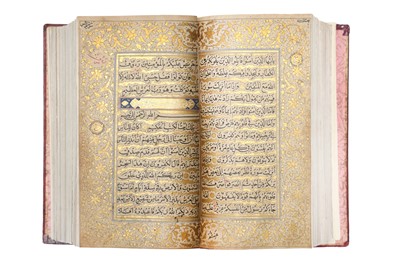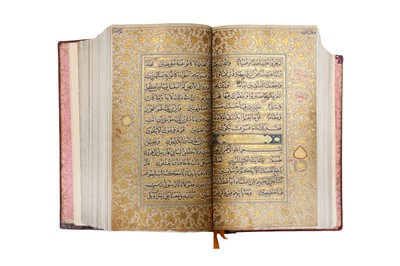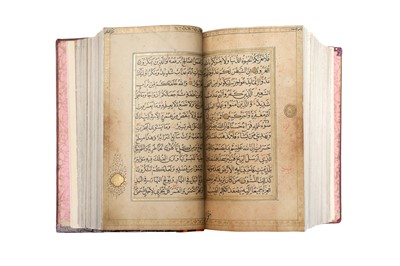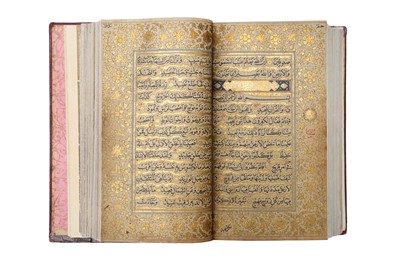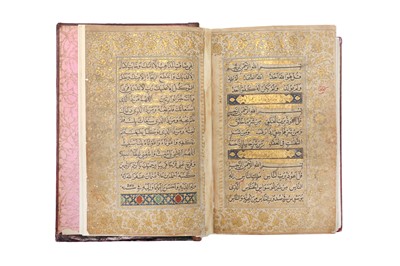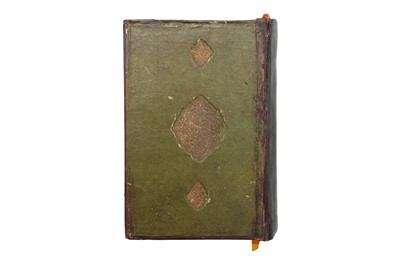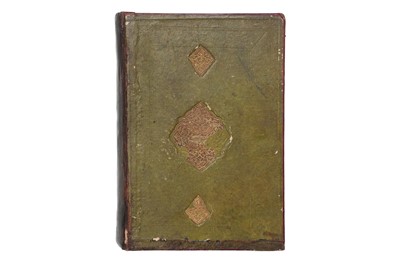28th Oct, 2022 14:00
Islamic & Indian Art
A FINE MUGHAL INDIAN QUR’AN
Possibly Golconda or Hyderabad, Deccan, Mughal India, signed Ahmad bin Mulla Uthman, dated 1145 AH (1732)
A FINE MUGHAL INDIAN QUR’AN
Possibly Golconda or Hyderabad, Deccan, Mughal India, signed Ahmad bin Mulla Uthman, dated 1145 AH (1732)
Arabic manuscript on paper, 445ff. plus 11 fly-leaves, each folio with 13ll. of black ink naskh script, the opening bifolio with sumptuous gold and polychrome illumination, the text with interlinear gold cloudbands, the subsequent bifolio elegantly illuminated throughout, further illuminated folios and margins with elegant floral scrolls, black diacritic marks, red intonation marks, catchwords, margins with further minor gold floral borders including the name of each aya on the top left-hand corner, marginal hizb, rub’, nisf, juz', and sajda markers in illuminated cartouches of various forms, sura headings in white thuluth within burnished gold cartouches, set within black, blue, and gold rules, the colophon signed by Ahmad bin Mulla Uthman, dated 1145 AH, in pink endpapers, in later gold-stamped green morocco binding, the text panel 14.7cm x 7.5cm, the folio 21.4cm x 12cm.
Provenance: Christie's London, 26 October 2017, lot 158.
The Qur'an production in pre-Mughal India is characterised by a great variety of styles and scripts. Such diversity seems to have continued as well in the Golden Age of the Mughal Empire, under the reigns of Emperor Akbar (r. 1556 - 1605), Jahangir (r. 1605 - 1627), and Shah Jahan (r. 1628 - 1658). It would appear that the patronage of Qur'an manuscripts was a low priority for these rulers, especially compared to their fondness for miniature paintings and calligraphic muraqqa' albums. It was only under Aurangzeb's reign (1658 - 1707) and later on, in the 18th century, that the production of Indian Qur'ans witnessed its first true moment of glory through eminent royal commissions and stylistic standardisation. In fact, the earliest Indian Qur'an with an explicit dedication to a ruling member of the Mughal dynasty is the one copied for Muhammad Shah (r. 1719 - 1748) by Muhammad Riza ibn Muhammad Taqi Tabrizi and completed at Shahjahanabad (modern-day Delhi) on 23 Ramadan 1143 AH (1 April 1732), sold at Christie's London, 7 April 1995, lot 47 (M. Bayani in The Decorated Word: Qur'ans of the 17th to 19th centuries, Part I, 1999, pp. 171 - 172). This manuscript was produced only two years before the present example.
18th-century Indian Qur'ans tend to distinguish themselves for their use of a very clear and crisp black ink naskh script (the favourite of Emperor Aurangzeb); their abundance of gold and polychrome pigments, especially in the opening folios and headings; and the variety of their floral decor, especially around the borders. A masterful example showcasing such qualities is the single-volume Qur'an attributed to Golconda or Hyderabad in the Khalili Collection of Islamic Art (no. QUR216), published in The Decorated Word: Qur'ans of the 17th to 19th centuries, Part I, 1999, cat. 68, pp. 208 - 215. The illumination on the opening folios of the first two Qur'anic suras is very sumptuous, presenting the text set against cloudband reserved in a gold ground and enhanced with polychrome-painted scrolling floral trellis. The floral meanders continue, in a larger size, around the borders. The sura headings are arranged within cusped cartouches on burnished gold ground. Though more schematic, the decorative repertoire of the illumination on the present example's opening folios shows clear analogies with the Khalili QUR216 manuscript and with another mid-18th-century Indian Qur'an, also part of the Khalili collection (no. QUR165). The illumination on this latter example acts as a testimony of later Mughal works on paper, characterised by subtle colours and a more rigorous, almost geometric, approach to the layout of the decoration on the page. Similarly to our lot, the opening pages of manuscript QUR165 are edged with a repeating pattern of floral finials in blue. Lastly, another quality of the present lot worthy of mention is the opulent use of dense golden floral borders on pages beyond the opening folios and colophon. Attuned to the great tradition of Mughal albums and their richly illuminated borders, the enhancement of secondary pages in the middle of the manuscript with floral motifs seems such a perfectly fitting choice for this Indian Qur'an, where the rigour of the black ink naskh script marries the uplifting warmth and divertissement of gold and polychrome-painted Indian flowers.
Sold for £10,000
Includes Buyer's Premium
Do you have an item similar to the item above? If so please click the link below to submit a free online valuation request through our website.
